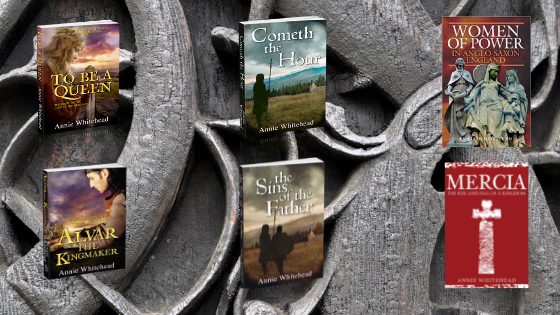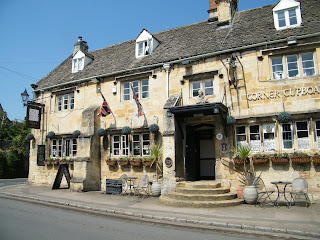The 'C' version of the Anglo-Saxon Chronicle, incorporating the annals known as The Mercian Register, tells us:
"In this year before midsummer, on 16th June, the day of the festival of St Quiricus the Martyr, abbot Ecgberht, who had done nothing to deserve it, was slain together with his companions. Three days later Æthelflæd sent an army into Wales and stormed Brecenanmere [at Llangorse lake near Brecon] and there captured the wife of the king and thirty-three other persons."We cannot know much about the unfortunate abbot, (a search of the Prosopography of Anglo-Saxon England [PASE] reveals only that single mention of him) save that he was sufficiently dear to Æthelflæd that she was prepared to avenge his life in such a forceful manner.
So what can we discover about Brecenanmere, and the unnamed king, whose wife was captured?
In his book, The Making of Mercia, Ian Walker says that the Mercian Register "... records the destruction of the royal crannog of Tewdwr, king of Brycheiniog, on Llangorse lake in Brecon and the capture of his queen."
PASE lists two kings named Tewdwr. One of them is the father of Elise and both of these men are mentioned in Asser's Life of Alfred [1] as having submitted to Alfred. Alfred died in 899 so either of these men could, in theory, have still been alive and militarily active in 916.
The other Tewdwr is listed as Tewdwr ap Griffi ab Elise, who, as Teowdor, Subregulus, witnessed a charter of King Athelstan in 934. [2] The Welsh system of patronymics suggests that he must have been the grandson of Elise, although Kari Maund names him as Tewdwr ab Elise, suggesting a closer consanguineal relationship [3]
We cannot know why this abbot was killed, or why a king who had submitted to Alfred the Great chose to anger Alfred’s daughter in this way. Perhaps he fancied his chances against a weak female ruler. At this time, the king of Wessex was Alfred’s son, Æthelflæd’s brother, Edward the Elder. He and his sister were engaged in an active campaign of building fortified towns, such as the fortress at Chirbury (on the Welsh/English border, in 915) and perhaps there were hostilities between the English and the Welsh which have gone unrecorded.
In 916 Edward is recorded as being engaged in Essex, building a fortress at Maldon. Is it possible that this King Tewdwr thought that Æthelflæd, a mere woman, would do little in retribution while her brother was busy elsewhere? We cannot know, because as previously mentioned, we have few specific dates and only know that Edward was in Essex in ‘the summer.’ Tempting as it is to join these two facts together, we cannot be certain.
There can be no doubt, though, that Edward was busy, and that he trusted his sister with power and authority. Her husband, Æthelred of Mercia, had died in 911 but had, for some years before that, been incapacitated in some form. Edward, whilst minting Mercian coins in his name, had allowed Æthelflæd to lead Mercia during her husband’s prolonged illness and in 911, although Edward took control of London and Oxford, previously handed to Mercia by Alfred, he left his sister as nominal head of Mercia.
Brother and sister worked as a team in 917: while Edward built fortresses at Towcester and Wigingamere (unidentified), and received the submission of ‘Viking’ armies of Northampton, East Anglia, and Cambridge, Æthelflæd took the borough of Derby, one of the prized ‘five boroughs’ which Edward had vowed to prise back out of the invaders’ hands. [4] In 907, Chester had been ‘restored’ [5] although no mention is made of the person who led the army which starved the occupying Vikings out. Professor Simon Keynes confirmed my suspicion that it is safe to assume that Æthelred was, by this point, unwell, and that in all likelihood it was Æthelflæd who took the fight to the walls of Chester.
We have therefore, enough evidence, however scant in detail, from 907 and 917, to be comfortable with the notion that it was she who took the decision to send an army into Wales. What would they have found there?
The ‘crannog’ mentioned above probably looked something like this:
 |
| Credit: Garnet Davies Llangorselake.co.uk Lakeside Bar/Caravan Park |
It seems likely that this was the only crannog in Wales and the Museum Wales website [6] has this to say:
The crannog was carefully constructed of brushwood and sandstone boulders, reinforced and surrounded by several lines of oak plank palisade. Tree-ring dating of the well-preserved timbers has established that they were felled between AD889 and AD893. The site seems to have been influenced by Irish building techniques, and was possibly constructed with the assistance of an Irish master craftsman.
The kings of Brycheiniog claimed to be descended from a part-Irish dynasty, and their use of such an unusual and impressive construction may have enhanced their political standing and strengthened their claims to Irish ancestry.
Of Æthelflæd’s army's attack, the site says: “This record of an attack probably refers to the crannog, and the capture of the wife of king Tewdwr ap Elisedd. During excavation, a charred, burnt layer was uncovered - probably representing this attack.”
If this was indeed the structure which the Mercians attacked, and where they took a queen prisoner, then this place was being used at a royal ‘llys’, a high status secular site. Tewdwr himself obviously survived this battle, but of course we cannot be sure if he was even in residence on the day in question. The only information we have is that his wife and thirty-three other persons were captured. Conjecture is the preserve of the novelist, and I had a lot of fun filling in the gaps of this particular incident, but the historian cannot afford such luxuries.
 |
| Medieval Wales showing Brycheiniog |
What we can infer, though, is that retribution was swift but relatively merciful. The Anglo-Saxon Chronicle mentions the killing of the abbot, but no revenge killings of any high-status Welsh. Æthelflæd had no further trouble from beyond the border. As we have seen, she went on to retake Derby (although the chronicle laments the loss of “four of her thegns, who were dear to her.”)
Early in 918, she obtained control of Leicester (another of the five boroughs) and, later in the year, the second battle of Corbridge, involving Ragnall against the Scots with the English Northumbrians, seems to have brought the people of York, wishing for a strong southern ally against Ragnall and his Norse Vikings, to Æthelflæd’s court, seeking her assistance.
We must be careful how we interpret the events at Llangorse. In my novel, I had Æthelflæd personally leading the army into Wales but the Mercian Register says only that she 'sent' the army and we cannot be sure whether she was in direct command. Even so, that she either sent, or led, an army into another country to avenge a death of a friend, seems remarkable yet plausible when we piece together all we know of Æthelflæd’s life. However few those facts are, they add up to one - that she was indeed, a remarkable woman.
[1] Asser Vit.Alfredi 80
[2] Charter S425 King Athelstan to Ælfwald, minister; grant of 12 hides (cassatae) at Derantune (probably Durrington, Sussex).
[3] The Welsh Kings - Kari Maund (Tempus)
[4] the five boroughs: Derby, Leicester, Lincoln, Nottingham and Stamford.
[5] Anglo-Saxon Chronicle
A version of this post originally appeared on the EHFA Blog
The life story of the Lady of the Mercians is told my novel To Be A Queen and the life and careers of her and her husband are included in my history Mercia: The Rise and Fall of a Kingdom - paperback available for pre-order at Amazon
The Lady also has a section in my new book, Women of Power on Anglo-Saxon England, available now: Amazon
The Lady also has a section in my new book, Women of Power on Anglo-Saxon England, available now: Amazon
































